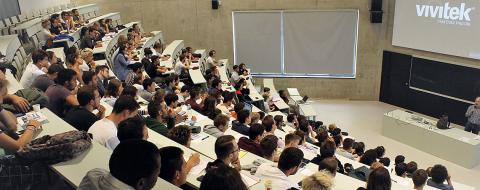
Training - Graduate School « Physics »

Master
- The Master of Physics welcomes more than 500 national or international students, French or English speaking. Strongly backed by research, it covers all aspects of physics, from its most fundamental aspects to its most concrete applications. Université Paris-Saclay offers a unique setting thanks to the very high concentration of prestigious research laboratories and the dynamic establishment of large companies and high-tech start-ups on its campuses. This very high potential allows for a remarkably diversified training offer, from foundations to applications, with teaching approaches adapted to each student.
The entire spectrum of physics is covered, from atomic and molecular physics, plasmas, via condensed matter physics and statistical physics, to nuclear, particle and astroparticle physics, astrophysics and cosmology. It includes experimentation, theory, numerical simulation, laboratory physics as well as that practised in large research facilities, encompassing major programmes conducted worldwide. This disciplinary training is enriched by taking into account societal interests and the socio-economic world in the fields of health and life sciences, energy and the environment, information and data processing, and the electronic devices of the future.

Doctorate
The doctoral area of the Physics Graduate School is mainly organised into four Doctoral Schools: EDOM, PHENIICS, AAIF and PIF, with about 540 doctoral students and 200 thesis defences per year. Their activities are gathered inside the Phd Program Physics of the Graduate School Physics.
- EDOM (Doctoral School Waves & Matter, ED 572) covers optics and dilute matter: quantum physics, optics, atomic and molecular physics, laser physics, plasma physics, nanophotonics as well as the interface domains of these fields (biomedical imaging, condensed matter, etc.), all types of plasmas (cold, hot, astrophysical, and fusion) as well as their technological applications (fusion by magnetic confinement, etc.).
- PHENIICS (Particles, Hadrons, Energy, Nuclei, Instrumentation, Imaging, Cosmos & Simulation, ED 576) broadly covers the themes of the P2i axis: particle physics, nuclei physics, cosmology, high-energy astrophysics, nuclear energy, theoretical physics related to experiments (phenomenology, quantum field theory, gravitation, etc.), advanced instrumentation (accelerators, detectors, simulation, computing), technical and societal applications (radiochemistry, medical imaging, radiotherapy, ionising radiation metrology, etc.).
- AAIF (Astronomy & Astrophysics in Île-de-France, ED127) covers the entire interdisciplinary field of astrophysics and its observation, measurement and computing methods: extrasolar planets, cosmology, evolution of galaxies, star formation and planetary systems, astrochemistry, in situ exploration of the solar system, planetology, instrumentation and advanced technologies for space and Earth observations (optics, metrology, cryogenics, automation, etc.).
- EDPIF (Doctoral School Physics in Île-de-France, ED564) is dedicated to fundamental physics, both theoretical and experimental, and the applications that flow naturally from it: physics of fundamental interactions, quantum physics of dilute or condensed matter, statistical physics, physics of soft or biological matter, fundamental aspects of optics, acoustics and hydrodynamics.
EDOM & PHENIICS are on-site Doctoral Schools, while both AAIF and PIF are co-accredited by Paris Sciences et Lettres (lead institution), Sorbonne Université, Université Sorbonne Paris-Cité, and Université Paris-Saclay.
Doctoral theses in physics can also be undertaken in two other Doctoral Schools which have a secondary connection with the Physics GS:
- EOBE (Electrical, Optical, Biophysics and Engineering, ED 575), covering a continuum between basic research and applications in the fields of electrical engineering in the broadest sense. A significant part of the fields represented are at the engineering-physics interface (optics, photonics, optoelectronics, medical imaging, nanosciences and nanotechnologies, spintronics, materials). A quarter of the doctoral students are graduates of Masters in Physics.
- Interfaces (ED 573), focusing on research requiring multidisciplinary understanding, particularly with regard to innovative materials and their applications, and the engineering of complex systems. It is thus situated at the interface of physics, chemistry, biology, mechanics and applied mathematics.




